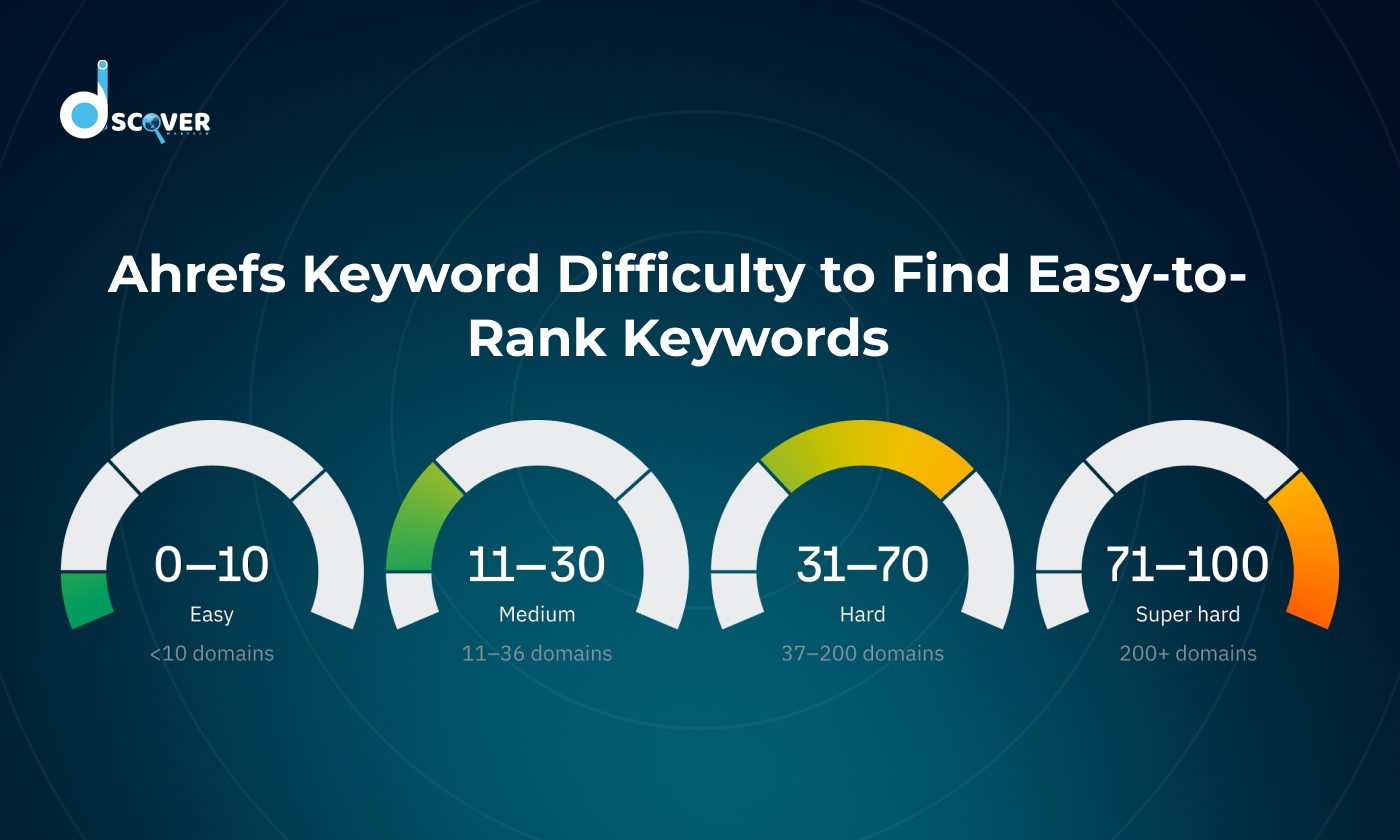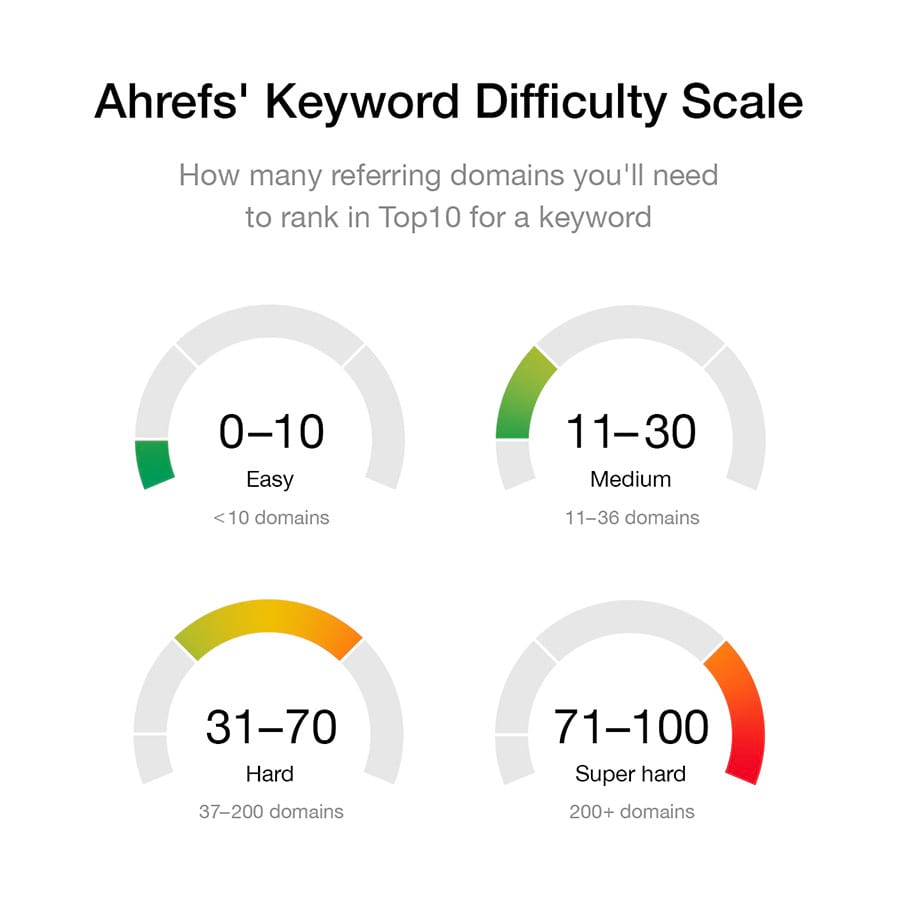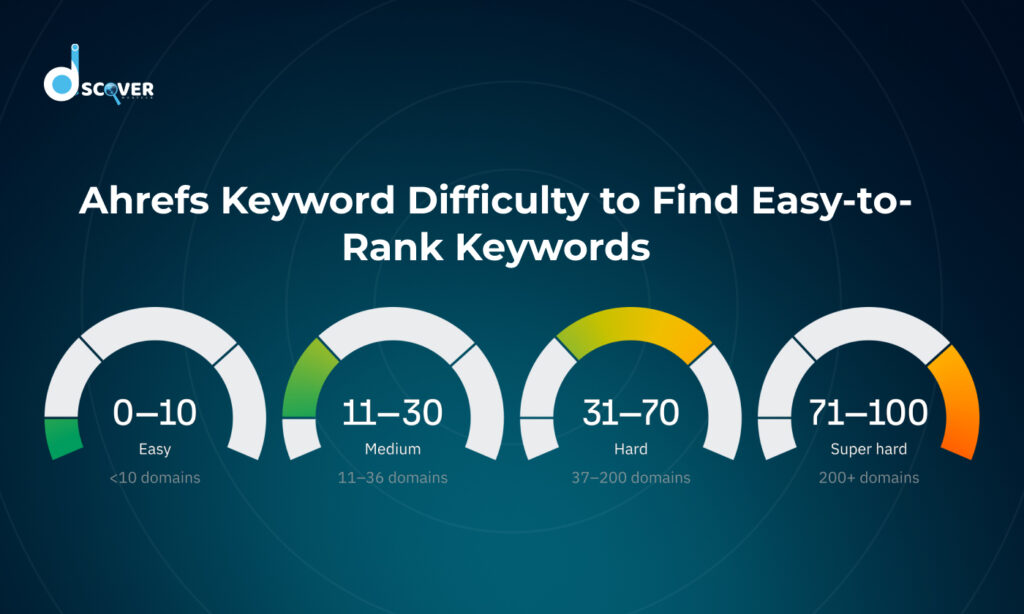
Finding easy-to-rank keywords can make a big difference in your SEO success. Whether you’re a blogger, a marketer, or running your own website, targeting the right keywords helps you save time and see results faster. That’s where Ahrefs Keyword Difficulty comes into play. It’s a simple yet powerful metric that helps you understand how competitive a keyword is—based mainly on backlinks.
In this guide, we’ll break down how to use Ahrefs Keyword Difficulty to uncover smart keyword opportunities and compare it with similar features from SEMrush, Google Keyword Planner, and Ubersuggest. But throughout, our focus will remain on how Ahrefs gives you an edge in SEO.
What is Ahrefs Keyword Difficulty?
Ahrefs Keyword Difficulty (KD) is a score between 0 and 100 that shows how hard it is to rank on the first page of Google for a given keyword. This score is calculated by looking at the backlink profiles of the top 10 ranking pages.
Here’s a simple breakdown:
- 0–10: Very easy to rank
- 11–30: Easy
- 31–70: Moderate to hard
- 71–100: Very difficult

Unlike other tools that consider many different factors, Ahrefs keeps things focused. It looks at backlinks, which are still one of the strongest ranking signals in SEO.
Why Keyword Difficulty Matters
Knowing how difficult a keyword is can help you:
- Choose battles you can actually win in search rankings
- Avoid spending time and effort on keywords you can’t rank for (yet)
- Plan a smarter content strategy with realistic SEO goals
- Find long-tail keywords with better chances of ranking and higher intent
When you combine keyword difficulty with search volume and intent, you can make much better decisions about which content to create.
How to Use Ahrefs Keyword Difficulty to Find Easy-to-Rank Keywords
1. Start with Keyword Explorer
Log into Ahrefs and go to the Keyword Explorer tool. Type in a broad keyword related to your niche (like “content marketing tips”) and click search.
You’ll see a dashboard with all the data you need, including:
- Keyword Difficulty
- Monthly Search Volume
- Cost Per Click (CPC)
- Parent Topic
- Related keyword ideas
- SERP overview
Start with a general idea and then explore variations or related keywords.
2. Use Filters to Find Low-KD Keywords
Ahrefs makes it easy to filter keywords by difficulty score.
Try these settings:
- Keyword Difficulty: 0–20
- Search Volume: 100 or more
- Word Count: 3 or more (to find long-tail keywords)
This helps you find low-competition keywords that still have decent traffic potential. These are especially useful if your site is new or doesn’t yet have a strong backlink profile.
3. Look at the SERP Overview
Click on a keyword that looks promising and scroll down to the SERP overview.
Here’s what to check:
- How many backlinks do the top-ranking pages have?
- Are there any low-authority domains ranking?
- Is the content weak, outdated, or irrelevant?
Even if a keyword has a KD of 25, but the current top results are weak, you may still have a shot at ranking.
4. Check the Parent Topic
Ahrefs shows the “Parent Topic” for each keyword. This tells you whether your keyword can rank as part of a broader topic.
This is helpful for:
- Avoiding keyword cannibalization
- Planning pillar and cluster content
- Ranking for more than one keyword with the same page
5. Save and Group Your Keywords
Once you find a bunch of easy-to-rank keywords, save them into lists. You can group related keywords into clusters and use them to plan out your blog posts, service pages, or landing pages.
If you want to go deeper, try the Content Gap feature to find keywords your competitors are ranking for that you’re not targeting yet.
How Ahrefs Keyword Difficulty Compares to Other Tools
Now let’s look at how Ahrefs stacks up against some other popular SEO tools.
Ahrefs vs SEMrush
When comparing Ahrefs and SEMrush for keyword difficulty analysis, the main difference lies in how each tool calculates the score. Ahrefs bases its Keyword Difficulty (KD) metric solely on the number and strength of backlinks pointing to the top-ranking pages. This approach gives a straightforward view of how competitive a keyword is from a backlink perspective.
On the other hand, SEMrush uses a more complex formula that considers several elements including domain authority, the presence of SERP features, keyword search volume, and traffic data. While this can offer a more comprehensive view, it may feel overwhelming or inconsistent to beginners or users who prefer a cleaner analysis.
In terms of interface and performance, Ahrefs provides a faster and more intuitive user experience, whereas SEMrush, though powerful, can feel more data-heavy and slower to navigate, especially when working with large sets of keywords.
Ahrefs vs Google Keyword Planner
Google Keyword Planner, while commonly used for keyword research, is primarily built for advertisers running Google Ads campaigns. As a result, its “competition” metric refers to advertiser competition, not SEO difficulty. This can be misleading for those trying to rank organically.
Unlike Ahrefs, Google Keyword Planner does not provide a dedicated keyword difficulty score for organic search. It also tends to show search volume in ranges (like 1k–10k), making it harder to make precise decisions.
In contrast, Ahrefs is designed specifically for SEO professionals. It offers accurate, keyword-level difficulty scores and exact search volume data, making it far more reliable for organic content strategy. If your main goal is SEO rather than paid ads, Ahrefs is the more focused and actionable tool.
Ahrefs vs Ubersuggest
Ubersuggest is a beginner-friendly tool that provides keyword difficulty scores and basic SEO data. However, its keyword difficulty scores tend to be less precise compared to Ahrefs, particularly for competitive or niche topics.
Ahrefs, with its massive link database and proprietary crawler, offers more accurate difficulty scores and deeper data overall. This includes detailed SERP analysis, backlink insights, and content gap tools, which are either simplified or missing in Ubersuggest.
That said, Ubersuggest offers a generous free tier, which makes it a great entry-level tool for bloggers and small businesses. But for users who want reliable, in-depth data and consistent performance, Ahrefs is the better long-term SEO investment.
A Quick Real-World Example
Imagine you run a blog about budgeting tips. You want to find keywords that are low competition but still valuable.
Here’s what you do:
- Head to Ahrefs Keyword Explorer
- Enter “budgeting for students”
- Set filters: KD 0–15, Volume 100+, Word Count 3+
You might find keywords like:
- “how to budget as a college student” (KD 11)
- “student grocery budgeting tips” (KD 8)
These are keywords you could realistically rank for with a well-written blog post, even without many backlinks. That’s the power of using KD filters smartly.
Best Practices for Using Keyword Difficulty in Ahrefs
Here are a few tips to keep in mind as you use the KD metric:
- Always pair KD with search intent. A keyword may be easy to rank, but is it relevant?
- Don’t avoid higher-KD keywords forever. Once your domain authority grows, you can go after more competitive terms.
- Use KD for prioritizing, not deciding everything. Look at SERP pages manually before choosing your final targets.
- Keep updating your content to stay competitive in the rankings.
Final Thoughts
Ahrefs Keyword Difficulty is one of the most reliable SEO metrics out there. It’s simple, data-driven, and especially helpful when you’re building a content plan or targeting quick-win keywords.
By using KD filters, SERP analysis, and parent topic data, you can confidently find keyword opportunities that match your website’s current strength—and build a solid foundation for long-term growth.
Checkout our new blog on “CMS Showdown: Comparing WordPress, Joomla, Drupal & More – Which One is Best for You?”
Contact us for our Digital Marketing service



